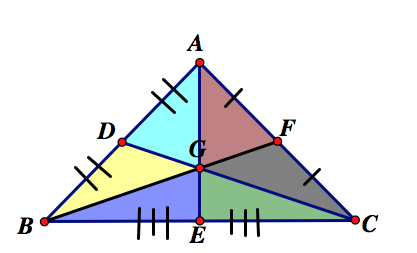

Centroids: The Power of 6 in 1
By: Russell Lawless
In mathematics we define the centroid of a triangle to be the point of intersection where the three medians of the triangle meet. A median is the line segment that is formed by a vertex of a triangle and the midpoint that is on the opposite side of the triangle. The centroid is point G, the medians of the segments are points D, F, and E, and the vertices of the triangle are points A, B, and C.
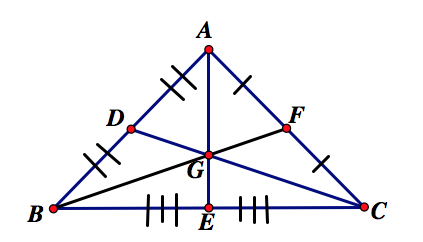
We will be focusing on the idea that the centroid divides up the triangle into six smaller triangles which all have the same area. To do this we will prove that:
ΔAGD ≅ ΔAGF ≅ ΔFGC ≅ ΔCGE ≅ EGB ≅ ΔBGD (in regards to area).
For proving that ΔAGF ≅ ΔFGC (in regards to area) we will be using the formula for the area of a triangle which is A = ½ bh. We see that both triangles have the same height due to them sharing the same side, segment GF. We then see that the base of each triangle is the same, segment AF and segment FC. This is known because point F is the midpoint of segment AC. Therefore, ΔAGF and ΔFGC have the same height and base so we can assign each of these with the variables b and h for both triangles. So since we know that the formula for a triangle is A = ½ bh, then ΔAGF ≅ ΔFGC (in regards to area).
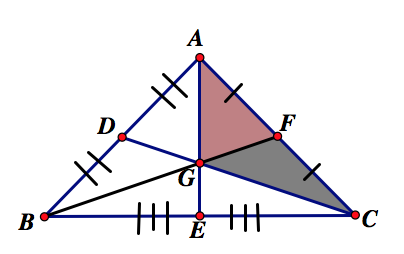
For proving that ΔCGE ≅ ΔEGB (in regards to area) we will be using the same formula for the area of a triangle. We see that both triangles have the same height due to them sharing the same side, segment GE. We then see that the base of each triangle is the same, segment CE and segment EB. This is known because point E is the midpoint of segment BC. Therefore, ΔCGE and ΔEGB have the same height and base so we can assign each of these with the variables b and h for both triangles. Since we know that the formula for a triangle is A = ½ bh, then ΔCGE ≅ ΔEGB (in regards to area).
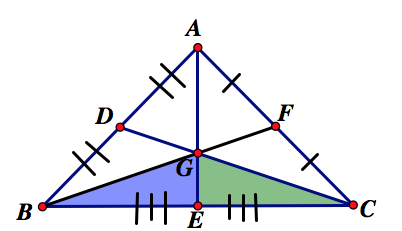
For proving that ΔAGD ≅ ΔBGD (in regards to area) we will be using the same formula for the area of a triangle. We see that both triangles have the same height due to them sharing the same side, segment GD. We then see that the base of each triangle is the same, segment AD and segment DB. This is known because point D is the midpoint of segment AB. Therefore, ΔAGD and ΔBGD have the same height and base so we can assign each of these with the variables b and h for both triangles. Since we know that the formula for a triangle is A = ½ bh, then ΔAGD ≅ ΔBGD (in regards to area).
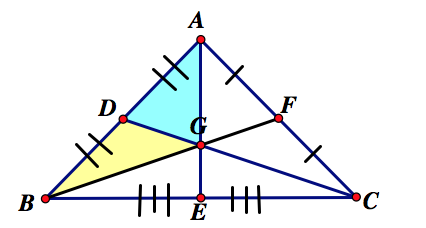
We have now proved that ΔAGD and ΔBGD have the same area, ΔCGE and ΔEGB have the same area, and ΔAGF and ΔFGC have the same area. However, our proof is not done.We now must prove that ΔAGB, ΔAGC, and ΔBGC all have the same area. In order to do this we need to cut ΔABC into two different sections, ΔAEB and ΔAEC.
For proving that ΔAEC ≅ ΔAEB (in regards to area) we will be using the same formula for the area of a triangle. We see that both triangles have the same height due to them sharing the same side, segment AE. We then see that the base of each triangle is the same, segment BE and segment EC. This is known because point E is the midpoint of segment BC. Therefore, ΔAEC and ΔAEB have the same height and base so we can assign each of these with the variables b and h for both triangles. Since we know that the formula for a triangle is A = ½ bh, then ΔAEC ≅ ΔAEB (in regards to area).
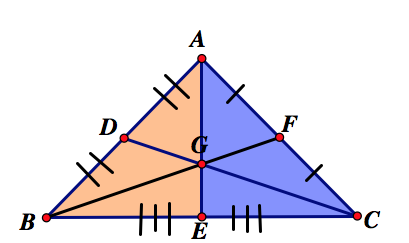
Now since we know that ΔAEC has the same area of ΔAEB we want to look at the individual triangles to show that all 6 are equal to each other. To do this we will leave them in the classifications of our 3 larger triangles. Let the area of ΔAGF and ΔFGC equal p, ΔAGD and ΔBGD equal g, and ΔCGE and ΔEGB equal r. So,
2g + r = 2p + r (subtract r on both sides)
2g = 2p (divide by 2)
g = p
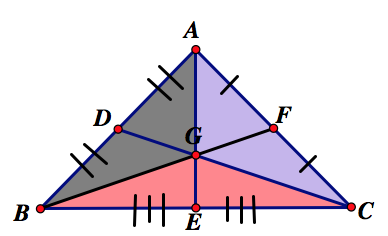
This shows us that one grey triangle has the same area as one purple triangle. So we have now shown ΔAGD ≅ ΔAGF ≅ ΔFGC ≅ ΔBGD (in regards to area). Now let's do the same thing for ΔBFA and ΔBFC.
For proving that ΔBFA ≅ ΔBFC (in regards to area) we will be using the same formula for the area of a triangle. We see that both triangles have the same height due to them sharing the same side, segment BF. We then see that the base of each triangle is the same, segment FA and segment CF. This is known because point F is the midpoint of segment AC. Therefore, ΔBFA and ΔBFC have the same height and base so we can assign each of these with the variables b and h for both triangles. Since we know that the formula for a triangle is A = ½ bh, then ΔBFA ≅ ΔBFC (in regards to area).
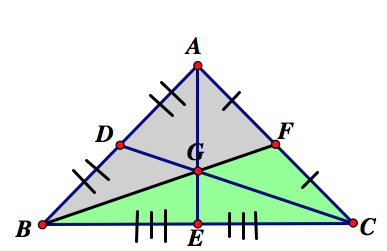
Now since we know that ΔBFA has the same area of ΔBFC we want to look at the individual triangles to show that all 6 are equal to each other. To do this we will leave them in the classifications of our 3 larger triangles. Let the area of ΔAGF and ΔFGC equal p, ΔAGD and ΔBGD equal g, and ΔCGE and ΔEGB equal r. So,
2r + p = 2g + p (subtract p on both sides)
2r = 2g (divide by 2)
r = g
So we see that the

So we see that the one red triangle will have the same area of one grey triangle which means that one red triangle will also have the same area as one purple triangle.
Therefore, ΔAGD ≅ ΔAGF ≅ ΔFGC ≅ ΔCGE ≅ EGB ≅ ΔBGD (in regards to area).
